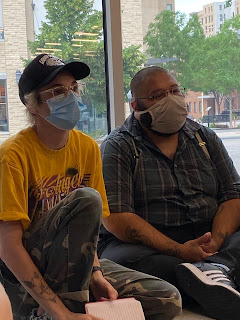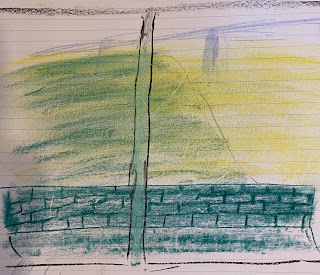Many teachers have shared that the program is helping them reconnect to teaching, combat burnout, and feel rejuvenated. In their feedback and reflections, they attribute this to:
● The careful creation of a strong sense of community and trust
● Responsive curriculum design and feeling heard
● Slowness and airiness-a focus on depth rather than breadth, iteration, spiraling curriculum, and being given time for deep thinking and making
● The mantra “Completion is not the goal” (Lucero)
● Movement segments & reconnecting to their bodies as instruments for learning
Movement and reflection: Teacher participants, Team members, and Advisory Board members expressed the necessity of movement and reflection as the key to processing in their learning experiences and communicated a desire to continue movement and reflective practices. One teacher noted, “the movement piece was absolutely essential to connecting all of this together,” while several others shared the impact of having “more time for reflection” and “reflection times” provided opportunities to slow down and process.
Challenges in project implementation and lessons for moving forward
Keeping teaching artists engaged
Teaching Artists were engaged during the concentrated summer workshops. During the academic year, their participation dropped off and was considerably more limited. We are working with our artists, board members and the art community to think about ways to productively engage artists throughout the life of the grant.
Recruiting administrators
In the post-COVID educational environment, it was hard for administrators to commit large chunks of time. As a result, we inverted the relationship and reached out individually to spend time with each administrator in a time they could find. We used our flexibility to compensate for Administrators' rigid schedules.
Grace
After the last two years of teaching during the Pandemic and Racial Reckoning, educators expressed exhaustion, and some were thinking of a career change. The Curriculum we constructed and adjusted took that reality into account, providing choice and “airiness”. As a result, teachers became more motivated and thought less about a career change. The grant had a significant positive impact on well-being and willingness to continue teaching. We will continue to reduce the number of transitions and give more time for the application of content, to expand the amount of time on the task.
What contributions the project has made to research, knowledge, practice, and/or policy.
The project is in its first year, and we have limited contributions so far:
Conducting a thematic analysis of post-workshop comments, we uncovered four key themes that were identified, including 1) Movement and Reflection, 2) Collaborative Community, 3) Studio Access and Tool Time, and 4) Curricular Revision and Classroom Implementation.
Movement and Reflection
Several teacher participants expressed the necessity of both movement and reflection as modes of pausing and processing in their learning experiences and communicated a desire to continue movement and reflective practices.
Collaborative Community
Teachers also indicated the benefit of building and maintaining a supportive network through collaboration, specifically through conversation, observing each other’s work, and developing relationships.
Studio Access and Tool Time
Teachers shared continued excitement about the development of EMA projects and learning about tools to continue materializing projects.
Curricular Revision and Classroom Implementation
Teacher participants revealed a need for increased time with TFU (Teaching for Understanding), classroom implementation, curricular revision, and focusing on subject content.
Acknowledgments:
Art TEAMs is made possible by the emergent, collaborative interactions between many individuals. A deep gratitude is extended to all who participated in the experience of teaching (and learning) with emerging media and arts, including teachers (Matt Auch-Moedy, Jessica Davis, Maggie Elsner, Sarah Gabelhouse, Kate Gracie, , Sarah Holz, Mark James, Sarah Kroenke, Ryan Margheim, Megan Pitrat, Katie Samson, Melissa Sellers, Amy Spilker, and Jessi Wiltshire,) for embracing ambiguity and vulnerability and expanding into new ways of seeing; administrators (Dr. Lynn Fuller) for holding space and having conversations about new ideas; museum educators (Laura Huntimer) for offering valuable educational resources; teaching artists (Cayleen Greene, Fernando Montejano, Angel Geller, and Isabella Meier) for sharing their creative processes; the advisory board (Megan Elliot, Dr. Jorge Lucero, and Dr. Diana Cornejo-Sanchez) for shepherding the design and development of the program; and the research team (Kimberley D’Adamo, Lorinda Rice, Guy Trainin, HyeonJin Yoon, and Maggie Bertsche, Carrie Bohmer, Mackayla Kelsey, and Gretchen Larsen) for weaving together the many pedagogic and curricular threads of a complex tapestry.



























